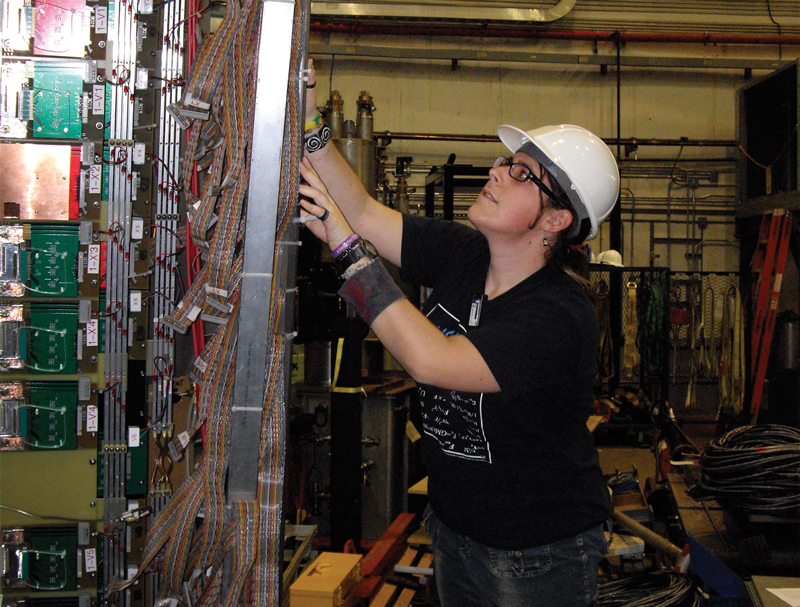Navigating Physics as a Fish out of Water
Fall
2014
Special Feature
Navigating Physics as a Fish out of Water
A Trans Woman’s Journey in Physics
By:Elena Long, Postdoctoral Research Associate
University of New Hampshire

In September I visited my undergrad alma mater, where I got my start in physics. The experience caused me to reflect on how far I’ve come since then.
I wasn’t the most traditional physics student. The first person in my family to attend a four-year college, I didn’t even realize that grad school was an option when I started my bachelor’s degree. As I began my journey to discover the richness of the physical world, I also began another journey: coming out as a queer transgender (“trans”) woman.
In college (and later, grad school) I had support for these disparate aspects of my life. At LGBT (lesbian, gay, bisexual, trans) support groups on campus, I met and connected with other students going through similar issues related to gender and sexual orientation. Meanwhile, I continued my physics career, finished my classes, passed my qualifier exams, and had the opportunity to study nuclear physics at an electron accelerator facility.
Extremely excited about the chance to work at a national lab, I packed my bags and moved halfway across the country to a place I had never even visited. If you ever get the opportunity to work at, or at least visit, an accelerator facility, do it. The physics done at the lab captivated me, and just being around the equipment we use to probe the inner structure of protons and neutrons still gives me chills.
As wonderful as the research was, I suddenly found myself a fish out of water in the lab. I was surrounded mostly by straight guys whose gender matched the sex assigned to them at birth (“cisgender”). The culture was one I had never been a part of, and there were no resources for LGBT people. The lab’s employment nondiscrimination policy didn’t even cover sexual orientation, gender identity, and gender expression.
In my isolation I started looking for resources and someone else who would understand. I Googled every letter of the LGBT acronym soup with “physics.” The message repeated over and over again, by everyone from research advisors to fellow students, was, “Shut up and never talk about it, and if you dare to talk about it anyway, it will destroy your career.” My experiences in the lab were, unfortunately, not unique among LGBT people in physics.
It was around this point that I attended my first large physics conference, organized by the American Physical Society (APS). Figuring that surely someone would know where I could find something, anything, I attended an event focused on women in physics. After the presentation, I gathered all of my courage to ask, “Where can I find resources for LGBT physicists?”
The room went silent. Then someone piped up: “Huh. We never thought of that.”
But because I asked the question, people came up to me afterward with suggestions, giving me names of other people to talk to about the topic. We gathered what little we could find on a website and put together the first-ever networking session for LGBT physicists, which took place at another APS conference. We talked about the issues that affected us as LGBT people in physics: the danger of employment discrimination, the value of inclusive health insurance policies, the lack of visibility, the importance of bathroom access, the immense pressure to never talk about our lives, and the culture we were working in that didn’t want to admit that we exist.
We were able to bring these issues to the greater physics community at the 2012 APS March Meeting session titled Sexual and Gender Diversity Issues in Physics, thanks largely to the efforts of the APS Committee on the Status of Women in Physics and the APS Committee on Minorities. We posed a question: How could our newly formed LGBT physicists organization help to address the issues we had identified? We then put together a best practices guide, which we keep up to date and expanded in collaboration with the AAS Working Group of LGBT Equality. No physicist who happens to be a sexual or gender minority should feel isolated and alone.
Ten years after my coming out in college, I am struck by how much work we still have to do. To this day, my undergraduate alma mater has taken only one action to address the needs of trans students: turning a men’s room into a gender-neutral restroom, a change made only to force a trans woman to not use the women’s restroom. Students are still harassed, verbally and physically, because of who they are.
Future physicists continue to be pushed away from the field due to a culture that doesn’t want to admit LGBT people exist. We, as physicists, can do so much better for the next generation. //
Continue the Conversation
Check out LGBT+Physicists at http://lgbtphysicists.org and read the group’s best practices guide here: http://lgbtphysicists.org/files/BestPracticesGuide.pdf.
